Contributor Catie Gould is co-chair of Bike Loud PDX and is sort of obsessed with tracking climate change news.
I had plenty to digest over the Thanksgiving holiday, including an important new progress report on the global battle against climate change.
Last Tuesday the United Nations released its annual Emissions Gap Report. This annual report tracks country-level progress on Paris Climate Agreement goals, and outlines not just our failings (which there are many) but also potential pathways to decarbonization in which urban policy is a major player.
In hopes of spicing up my Thanksgiving table conversations, I read all 108 pages of the report. What I found was both interesting and depressing (of course).
First, some context about where we are.
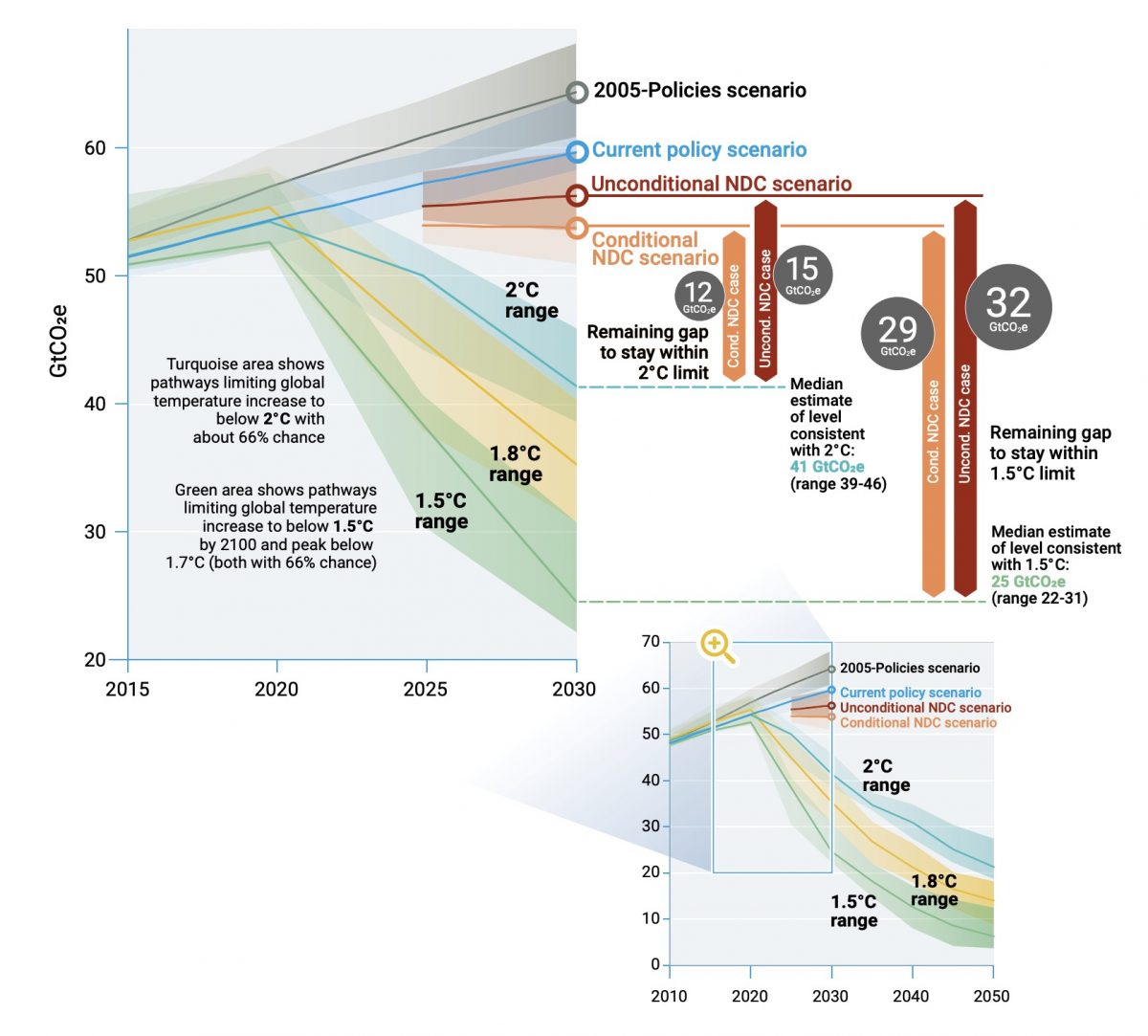
Emissions are still rising at 1.5% per year and hit a record high of 55.3 gigatonnes of CO2 equivalent in 2018. With current policies, total emissions are expected to rise to 60 gigatons by 2030. To put that in perspective, to have a reasonable chance of limiting warming to 1.5 deg C, emissions need to be cut to 25 gigatons by 2030, which graphs out to 7.6% per year. The good authors of the report produced this charming graphic. Those little red and orange lines represent the Nationally Determined Contributions (NDC) that were agreed to in Paris. Even if those targets were met (they aren’t) the world would see 3.2degrees C by 2100. Those country level targets need to increase fivefold to be in line with the science.
Advertisement
The United States is still the worst
It shouldn’t be a surprise that the United States of America is not on track to meet its original targets, with the recent rollbacks in the Clean Power Plan and fuel economy standards. However, CO2 emissions have fallen by 14% between 2005 and 2017 despite a growing economy. The report also points to action at state and local levels including the U.S. Climate Alliance, which Governor Kate Brown is a part of.
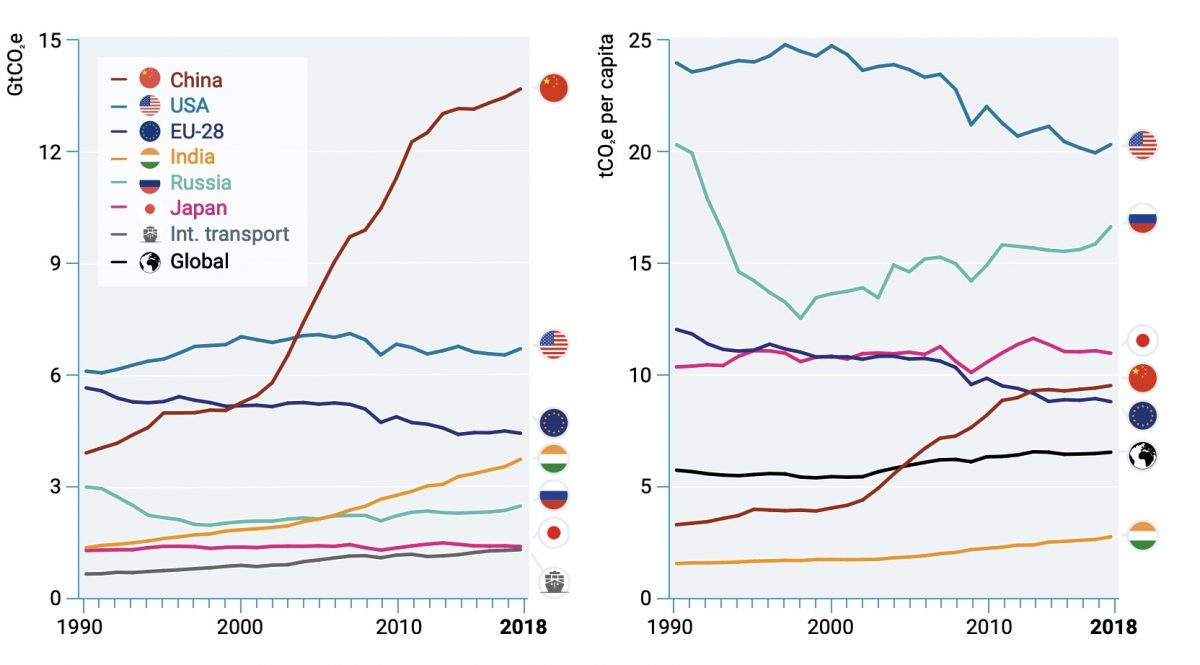
Some good numbers
The report cites a growing body of research being done on the benefits of taking action. Analysis by the Global Commission on the Economy and Climate estimates that ambitious climate action could generate US$26 trillion in economic benefits between now and 2030 and create 65 million jobs by 2030, while avoiding 700,000 premature deaths from air pollution. A global fossil fuel phase-out could avoid over 3 million premature deaths each year from outdoor air pollution
Advertisement
“The word parking only appeared in the report once, and highways not at all.”
The Transportation challenge
Transportation sector emissions are growing more rapidly than emissions on average, at a rate of 2.5% annually between 2010 and 2015. Electrifying vehicles is expected to play a major part in this transition, with falling battery prices expected to achieve cost parity with internal combustion engines in the mid 2020s. Transportation today accounts for only 1% of global electricity demand, but could expand to 40% by 2050.
Recommended actions for transportation were:
– Compact urban planning Reducing passenger travel demand
– Shifting travel modes & public transit investment
– Electrification and improved fuel efficiency for vehicles
– Freight logistics
There was surprisingly little about modal shift besides this short passage, “…short journeys account for two thirds of transport emissions in urban areas and could be replaced by active modes. Electrification of the vehicle fleet alongside mass transit and micromobility can replace diesel and petrol cars, making cities more liveable with lower pollution levels.” The word parking only appeared in the report once, and highways not at all.
Advertisement
While we often think of transportation emissions as the hard stuff compared to decarbonizing the grid, the report cites that shipping and aviation, which make up 40% of transport emissions globally, will be significantly more challenging to decarbonize and electrify than road transport. The world’s largest shipping container company, Maersk, is working on a commercial carbon neutral vessel by 2030, and Scotland and Norway have targeted decarbonizing domestic flights by 2040 through electrification. Scotland is planning to trial low or zero emission flights beginning in 2021.
US gets call out for SUV use
The United States makes up 13% of global emissions, but represents 25% of all light duty vehicle emissions. It states, “In recent years, there has been a trend towards larger, heavier vehicles, such as sports-utility vehicles (SUVs) and pick-up trucks, which require more materials and higher operational energy use. Reducing the share of SUVs and light trucks in the United States of America from the current 53 per cent to 32 per cent by 2050 would reduce emissions from the production and operation of cars by 10 per cent.” Higher registration fees for higher emitting vehicles is one tool credited for incentivizing small vehicle sizes in some European countries.
Carpooling is better than Carsharing
Current trends project that the number of vehicles on Earth are expected to double by 2040. Yikes. The report talks through different scenarios for reducing cars, but not all are equal. The International Resource Panel estimated that having 25 per cent of drivers shift to car sharing would reduce emissions by 10 per cent, while shifting 25 per cent of trips to shared rides would reduce emissions by 20 per cent. Policies that discourage low occupancy car sharing are vital to reduce the number of cars such as congestion pricing or priority lanes for 3 or more occupants. Automated vehicles also have the potential for efficient car sharing but came with a strong warning, “If unregulated, such a trend will also likely increase driving distances which would impact emissions and may move people away from using more efficient public transport.”
Advertisement
Upzone your Neighborhood, Downsize your home
The report points out an encouraging trend towards smaller family sizes which can be leveraged into more efficient homes. Urbanized areas are also expected to grow from 55% of the global population today to 70% by 2050, and in general the report notes that urban and multifamily dwellings are smaller than suburban or rural ones. The International Resource Panel suggests that reducing floor space by 20 per cent per person could reduce the emissions associated with producing building materials for homes by 50–60 per cent by 2050. This seems easily accomplished given that US housing averages 68 square meters (732sq ft) per person, compared to the UK 34 square meters (344sq ft).
Taking advantage of these demographic shifts require both residents and neighborhoods to be nimble. “Policies that support homeownership may have the undesirable effect of subsidizing large residences through tax breaks and other measures. In some locations, spatial planning prevents the construction of multifamily residences and locks in suburban forms at high social and environmental costs.”
Social movements are needed
Interwoven through the technical chapters is a topic much harder to graph. These shifts are not just technical, but cultural and need strong social support to be successful. “Legitimacy for decarbonization therefore requires massive social mobilization and investments in social cohesion to avoid exclusion and resistance to change. Just and timely transitions towards sustainability need to be developed, taking into account the interests and rights of people vulnerable to the impacts of climate change, of people and regions where decarbonization requires structural adjustments, and of future generations.”
That last part strikes home for me. Beyond learning everything I can about the topic, being involved with transportation activism gives me strength to keep fighting.
— Catie Gould @Citizen_Cate on Twitter.
— Get our headlines delivered to your inbox.
— Support this independent community media outlet with a one-time contribution or monthly subscription.



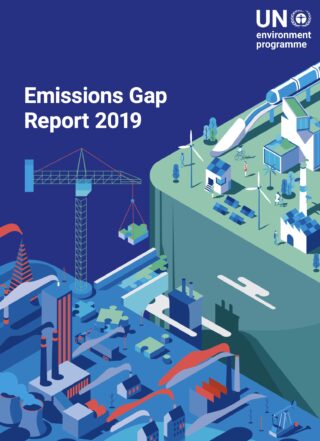
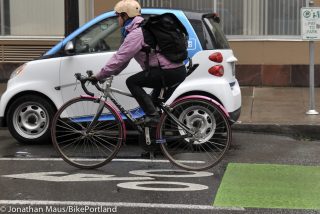


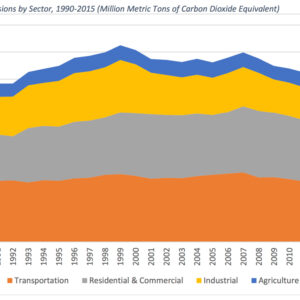

Thanks for reading.
BikePortland has served this community with independent community journalism since 2005. We rely on subscriptions from readers like you to survive. Your financial support is vital in keeping this valuable resource alive and well.
Please subscribe today to strengthen and expand our work.
Great article. Thanks for putting all of that together for the rest of us!
“However, CO2 emissions have fallen by 14% between 2005 and 2017 despite a growing economy.”
I wonder if this is due to the continued offshoring of production (nearly everything we buy is now manufactured in China). If production emissions are assigned to China then we could look better than we really are.
This offshoring of industry and emissions is very true, but the worst part is that by doing so we have substituted the dirty coal fired energy in China for the cleaner (relatively) electrical production ( hydro, natural gas , scrubbed coal) of North America. Unfortunately, China while implementing some renewables is also moving full speed ahead with more coal fired power plants on a massive scale.
“Unfortunately, China…”
China is significantly exceeding its Paris agreement CO2e reduction commitments (NDCs) while the USA is failing abysmally.
The UN Emissions Gap Report illustrates this in Figure 2.6a:
Well at least they are making up for their abysmal human rights record right?
Pot calling kettle black.
Thats because they have not fired up all these babies yet.
https://www.reuters.com/article/us-climate-change-china-coal/china-plans-226-gw-of-new-coal-power-projects-environmental-groups-idUSKBN1W40HS
No small part of this decrease is cherry picking. 2005 was the peak before a mini-bike boom that had a massive recession on its tail end, both of which significantly dropped emissions. We’re now seeing increases in the face of necessary reductions. There’s really nothing to feel good about here.
Super FANTASTIC write up. I was afraid to crack that monster. Now I dont! I mega trust Catie to nailed it! The key to advocacy is dont take it personal, keep pedaling, walk, smile and wave. Keep Portland Awesome!
Thanks, Catie! Great information, and I appreciated your good writing and humor to make the bad news a bit more palatable.
Thanks Catie!! I’ll continue to try to improve “spacial planning” on Portland, which is not as easy as it should be.
Don’t ignore the context! Part of the goal is to reduce the emissions associated with building; demolishing existing housing takes in the wrong direction.
You are correct that these numbers are for new construction, but the report does knowledge that extending the lifetimes of buildings has varied effects depending on the energy efficiency of existing housing.
This report does not reference any analysis of converting single family housing into multifamily using demolition or other methods: good, bad, or otherwise. Given the surrounding statements about dense urban centers and eliminating multi-family housing bans I did not draw that conclusion (demolition = bad), but other people here might be more familiar with research on that topic.
Human overpopulation on a dying planet. Nature has a way of dealing with overpopulations. It’s already too late to mitigate climate change. Enjoy every day. Have fun with it while you can and make it work for you.
We’re facing a global necessity of ~8% annual emissions reductions. Considering the fact that a good half of humanity is living such low-emissions lifestyles that they cannot make reductions without dying, that probably means we need to cut 16%/yr. Changing cars to electric isn’t going to make that kind of reduction, especially with their relatively high embodied emissions all front-loaded.
It’s staggering to think about the US cutting its emissions by a sixth each and every year going forward, especially when we are currently increasing them. It’s even more sobering to realize that we likely won’t make any cuts for the next few years, which will mean even steeper reductions going forward. Can we find the will to even try? We had better, because the alternatives aren’t very nice.
“It’s even more sobering to realize that we likely won’t make any cuts for the next few years”
That’s an optimistic scenario. Even the most aggressive plans (e.g. the various green new deals) have mitigation pathways that will take years to build out.
Demolishing one old house and replacing it with a new house lowers carbon emissions per year from then on, solely by virtue of the better insulation and more efficient heating and cooling in the new house. The carbon emitted by the demolition, and the construction of the new house is very soon overwhelmed by the savings in carbon from operation of the new house. If one old house is torn down and 3 are put in it’s place that’s 3 new, efficient houses, and since they’re probably smaller, the savings per house are even greater. Plus, if it’s close in, near to transit, the transportation emissions of the two new households on that site will likely be lower than had they lived further out, or in single-dwelling houses. So, the demolition and replacement in fact, takes us in the right direction.
Not to mention if one house is torn down and replaced by a 19-unit apartment building on a transit street! (Yes, I know, a 30-unit building would be even better since at least 4 of the units would have some level of “affordability”, but even the 19-unit building in a good location reduces carbon emissions for those 19 households, and for those 1- or 2-person households that make up 2/3 of Portland households, each unit is likely cheaper to rent than a single house would be)
Your eager deployment of the denominator is misplaced. 19 units on that lot is going to use many times more energy than the house that was there before. The fact that it is lower *per capita* makes some of us feel good but absent other changes it is meaningless or worse.
To take a car analogy: let’s say we all switched to driving the most feel efficient hybrid, overnight. In 20th Century parlance we would imagine a big win for ‘the environment,’ but we are well into the 21st Century, and efficiency as a strategy is not getting us there, is no longer helpful. We are on the hook to reduce TOTAL EMISSIONS by six-ten percent per year. If we all started driving hybrids tomorrow the emissions would spike due to 200 or 300 million new cars having been produced overnight, and the in-use reduction would likely be a fraction of what we need, which is to phase out fossil fuels entirely. Efficiency is a ratio, not a solution to our woes.
9watts: Of course a global increase in population makes the job of overall carbon reduction all the harder. But does that mean that we should concentrate all our effort on curbing worldwide population growth, to the exclusion of other efforts? I beleive that something we, in the US, can do, is try to reduce the extraordinarily high carbon emissions per person in our country, to do our part. Better insulation certainly is part of that, but so is smaller dwelling sizes per person, and so is common-wall (and -floors and -ceilings) dwellings, to reduce heat loss. And so also is location and density, to reduce the emissions generated by transportation.
Each of those 19 households close to downtown and transit is likely to generate less carbon than if those residents lived in single-family houses further from jobs and transit, no matter how well their houses were insulated.
All I’m saying is that there is nothing automatically beneficial about the pursuit of either housing density or energy efficiency. They can just as easily lead us to ruin as to salvation. Both are ratios, and unless we refocus attention on the growing denominators we are just whistling in the wind.
“a global increase in population makes the job of overall carbon reduction all the harder”
It is much worse than that. A _local_ increase in population growth coupled with a familiar focus on efficiency/density won’t move the needle, isn’t moving the needle. The takeaway from the article and report we are discussing here should be that our familiar strategies are not cutting it, are not serving us well, and to keep pretending they are is not helpful, makes us look foolish.
+1 9watts…the reliance on per capita statistics for GHG emissions is simply disingenuous
“Demolishing one old house and replacing it with a new house lowers carbon emissions per year from then on, solely by virtue of the better insulation and more efficient heating and cooling in the new house”
Sorry, Doug, but it isn’t nearly so easy. My 1894 house doesn’t use any fossil fuels for heating or cooling. Any existing house can be insulated for an infinitesimal amount of carbon: (shredded newspaper). And all the boilerplate about smaller houses in town being so efficient is fun, but with a growing population and no net loss of housing in the areas from which people are moving from this is all just smoke and mirrors. The atmosphere does not care about the denominator, about how many people or households we divide the total carbon emissions by, it only cares about the total. That total continues to rise inexorably every year.
9watts: Yes, you have done an excellent job in reducing carbon emissions from your old house, as well as from transportation. But we need to do what we can to reduce the carbon that a lot more people generate. As far as areas people are moving from, there is a net loss of households in some areas of the country (Detroit?). Some of this is natural increase, but in the US the rate of natural increase, as I’m sure you’re aware, has dropped significantly since a peak in 1955 of 14.9 persons per 1000, down to 3.23 in 2018. Yes, people are immigrating here, but we should be thinking more globally instead of just locally. It serves the planet better if folks are living in compact cities rather than sprawling ones, as their carbon footprint per person will be lower. And if people are moving here, we should, I believe, be doing our best to ensure that those that do move here have the choice of a lower-carbon place to live if they want.
Wouldn’t it be even more efficient to incentivize folks to relocate to already-efficient NYC rather than probably-always-inefficient Portland?
Soylent: Yes on New York, but people still seem to want to move here, so we need to make Portland the best we can, as well.
“It serves the planet better if folks are living in compact cities rather than sprawling ones, as their carbon footprint per person will be lower. And if people are moving here, we should, I believe, be doing our best to ensure that those that do move here have the choice of a lower-carbon place to live if they want.”
This is the party line. And most of my friends subscribe to it.
What I am suggesting is that this story we have been telling ourselves for forty years has been overtaken by history, is no longer helpful. In continuing to tell it this way we are acquiescing to
– population growth
– housing growth
– economic growth
– energy/emissions growth
– capitalist priorities and models of economic activity
none of which are compatible with where we need to be. We need to articulate a new post-fossil fuel, post-growth, post-capitalist story.
“Legitimacy for decarbonization therefore requires massive social mobilization and investments in social cohesion to avoid exclusion and resistance to change. ” While I completely agree with this, I still think a massive part of the problem is industrial nation governments not having a viable alternative to the current technological implementation.
Further to that, we need to think about cows and find some way to switch to a more sustainable carbon neutral method of farming meat.
forest cattle like the Finns used to do? or keep partly domesticated elk à la Sámi reindeer?
Problem solved:
https://impossiblefoods.com/burgerking/
Enjoy!
can’t tell if you’re serious or not, so I’ll assume that you are.
while I think the new fake meats are probably marginally better than industrially-produced beef, I don’t think they’re a win long-term. industrially-produced and -processed soy doesn’t seem like a great idea even if it’s less bad than what it’s replacing. maybe a step in the right direction, but far from dietary salvation.
“maybe a step in the right direction, but far from dietary salvation”
what does dietary salvation (whatever that means) have to do with decreasing meat and dairy-associated greenhouse gas emissions?
https://unfccc.int/climate-action/momentum-for-change/planetary-health/impossible-foods
dietary salvation… just my attempt at a clever turn of phrase. clearly a failure.
but what I mean is that the fake meats seem a lot like electric cars to me. less bad than what they replace, but not nearly good enough.
i think there is good evidence that plant-based protein foods are an excellent alternative to industrially-farmed animal products when it comes to reducing greenhouse gas emissions (see my link above).
i’m completely disinterested in the rating of foods based on their dietary “badness” because there is little scientific evidence that any particular food negatively impacts health.
my remark was not about immediate health impacts of any food. rather, it was about the environmental (and social) consequences.
I’m more than happy to agree that industrially-produced animal products are terrible. I’m not yet willing to agree that industrially-produced plant products are good alternatives, only that they are less bad (the link you posted notwithstanding).
Americans already eat double the amount of recommended protein so they don’t really need much animal-based protein to begin with. A diet that is mostly plants along with modest amounts of processed meat alternatives (bean patties, falafel, tofu, tempeh, seitan, soy curls, or even impossible burgers) is close to the optimal diet when it comes to reducing CO2e emissions.
Just keep going to your transportation committee meetings, writing your blog, and voting for Democrats. I’m sure everything is going to be fine.
Lacking children of my own, if my nieces and nephews and some other young people are going to survive the interesting times we have to commit ourselves and our resources very wisely and also yesterday.
While we get around to that we should absolutely seize the low hanging fruit. Carpooling was mentioned: it uses existing technology, nothing needs to be built (releasing more greenhouse gas), it’s a social practice and to make it work you just need to move some information around. We understand that.
New Prius: financial investment, scarce materials and embodied energy for a modest reduction in CO2.
Carpooling: no upfront investment, no mining takes place, no smelting, etc, etc, for a potential reduction of 50 to 75 % in pollution emitted per carpool rider. For people who won’t bike it’s a pretty big gain and it could start next week.
What would I-5 N look like if every third or fourth car went away? Your trucks would be on time, how about that?